

A water tank and broken windmill. The fan has fallen off and is lying behind the windmill (from this direction).
..back to the menu at the top..

Charcoal Burners along the track in Barmah Forest.
We are [Were] not entirely sure what these are, but there is a row of rusty boxes strewn
along the side of one of the tracks. Looking back through them at the ute in this shot.
Update 2012-02-17th: Kim from the Nathalia-Barmah Heritage centre found this page
and called to let me know these are charcoal burners. I'd probably know how they work except
our fax machine failed. Still, I did find out something about them.
From "The River: A Journey Through the Murray-Darling Basin" by Chris Hammer.
Another industry followed the loggers: sleeper cutting. The river red gum wood, hard as rock and water resistant, provided the foundations for railways snaking across the landscape. And not just within Australia. The railways of British India were being laid on the hard dark wood coming from Barmah. The streets of Melbourne were paved with 6-inch blocks, stood vertical and bitumened over. They're still there, virtually everlasting, cushioning the traffic along the city streets, unseen under the car wheels and tram tracks.
World War II came, first emptying the forest of men and then refilling it. Australia, with no domestic oil industry, was dependent on petroleum imports that were being sunk with sickening regularity by U-boats and German raiders. Petrol rationing was imposed and an ingenious alternative was developed: Charcoal burners. Charcoal was placed into containers and heated, giving off enough flammable gas to power a car. It wasn't the most convenient source of energy, nor the most powerful, but sixyt years ago Australians were using a fuel that was plentiful, carbon-neutral and renewable. Motorists would pull into service stations and instead of filling up with petrol, they'd buy bags of charcoal. The new industry brought new men to the forest, different men.
'There was a manpower shortage because all the men of that age were in the army or in vital jobs', Tim Mannion recalls 'So it became the job of internees, Italians or other foreign nationals. They put them in camps. They had to work under supervision or report to the police once a week. There were old fellows who were too old to be in the army, and anybody who thought they could earn a shilling. There were even prisoners of war. A fellow who was burning charcoal in the forest would be allocated a couple of prisoners to work for him.He had to look after them and they worked for them...'.
Ah, now here's an interesting link that gives a bit of a description .. http://fordsa.homestead.com/charcoal-1.html .. which I hope stays live for some time to come. Wikepedia also has a little to say on the subject.
From "The River: A Journey Through the Murray-Darling Basin" by Chris Hammer.
Another industry followed the loggers: sleeper cutting. The river red gum wood, hard as rock and water resistant, provided the foundations for railways snaking across the landscape. And not just within Australia. The railways of British India were being laid on the hard dark wood coming from Barmah. The streets of Melbourne were paved with 6-inch blocks, stood vertical and bitumened over. They're still there, virtually everlasting, cushioning the traffic along the city streets, unseen under the car wheels and tram tracks.
World War II came, first emptying the forest of men and then refilling it. Australia, with no domestic oil industry, was dependent on petroleum imports that were being sunk with sickening regularity by U-boats and German raiders. Petrol rationing was imposed and an ingenious alternative was developed: Charcoal burners. Charcoal was placed into containers and heated, giving off enough flammable gas to power a car. It wasn't the most convenient source of energy, nor the most powerful, but sixyt years ago Australians were using a fuel that was plentiful, carbon-neutral and renewable. Motorists would pull into service stations and instead of filling up with petrol, they'd buy bags of charcoal. The new industry brought new men to the forest, different men.
'There was a manpower shortage because all the men of that age were in the army or in vital jobs', Tim Mannion recalls 'So it became the job of internees, Italians or other foreign nationals. They put them in camps. They had to work under supervision or report to the police once a week. There were old fellows who were too old to be in the army, and anybody who thought they could earn a shilling. There were even prisoners of war. A fellow who was burning charcoal in the forest would be allocated a couple of prisoners to work for him.He had to look after them and they worked for them...'.
Ah, now here's an interesting link that gives a bit of a description .. http://fordsa.homestead.com/charcoal-1.html .. which I hope stays live for some time to come. Wikepedia also has a little to say on the subject.
..back to the menu at the top..
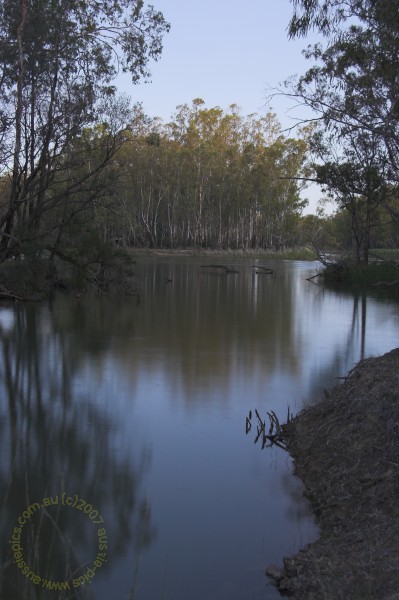
This is near where we pulled up for the night.
What I failed to get in this shot was the fade from pink to blue in the sky as the sun set.
What I failed to get in this shot was the fade from pink to blue in the sky as the sun set.
..back to the menu at the top..
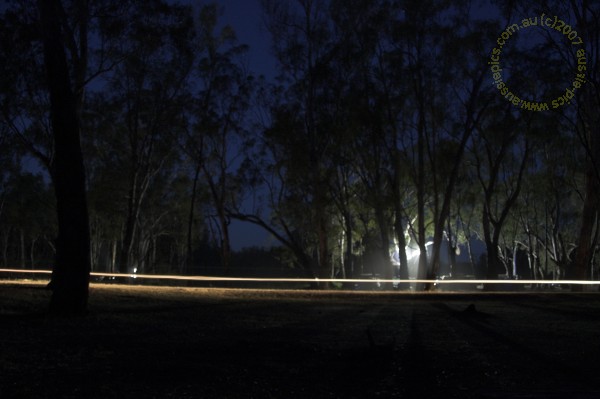
This is a rush shot, I saw the car coming and set up everything for a
long exposure, just in time. In my rush I didn't set the focus carefully,
so scaled down like this is the only way you'll see this picture.
..back to the menu at the top..
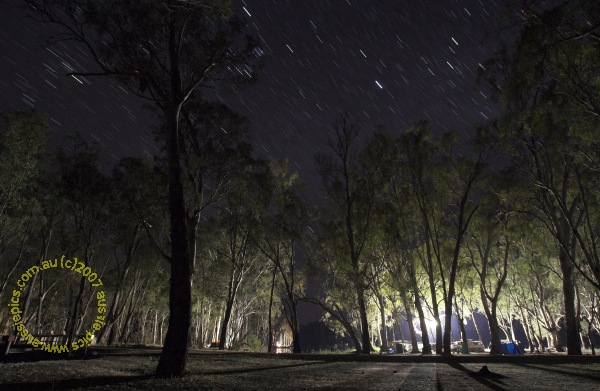
This is a more careful version, without the car passing through.
..back to the menu at the top..
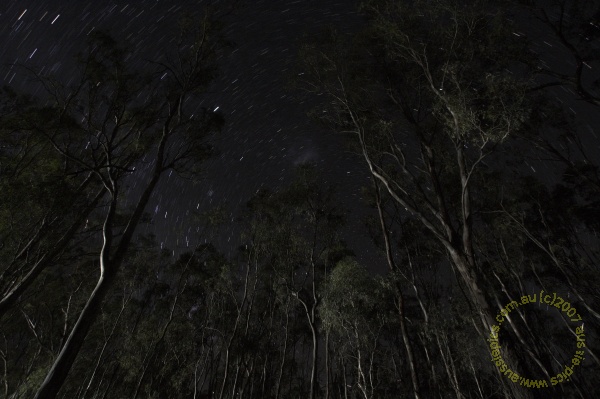
A night shot, with some backlighting from the campers over the track.
I'm afraid these scaled down shots don't show the night sky as well as the originals
If you squint, you may be able to track the satelite that zipped through this shot.
The circular tracks of the stars rotate around the south pole, which is where the stars
have remained dots instead of tracks. There is a 'cloud' of stars and/or gases
that probably just looks like a smudge slightly above and left of the
southern pole.
..back to the menu at the top..
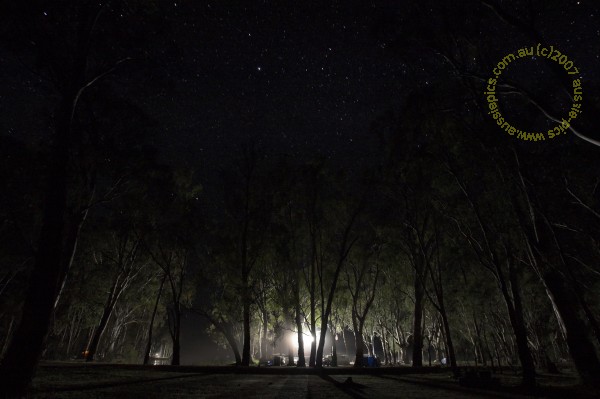
This was set up to be a 10 minute exposure, but the battery went flat sometime
during the shot. What is left still came out good.
..back to the menu at the top..
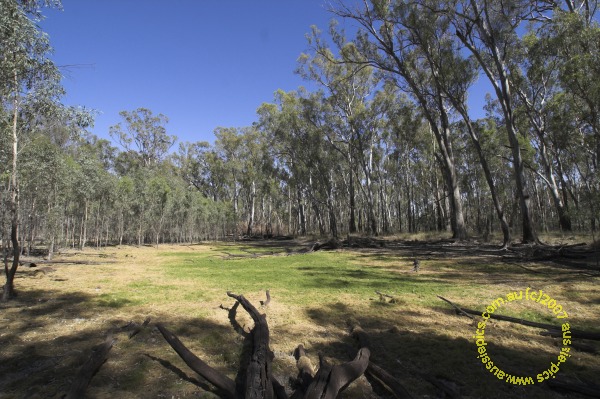
Next Morning. This is probably a shallow pool most of the year,
but in the middle of summer, it's a pool of gradually decreasing green.
..back to the menu at the top..
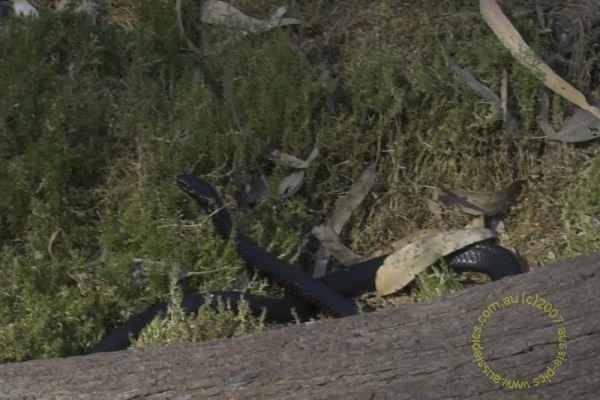
Ah..Summer in the bush, judging from what I saw, this is probably a red bellied black snake.
The belly was a real fire-engine red, but I was hopping out of the way at that point,
by the time I turned the camera onto it (at arms length, leaning in to stay as far away
as I could) it was flicking the tongue, and as the shutter went, so did the snake,
fortunately, in the other direction as it moved quite fast.
..back to the menu at the top..
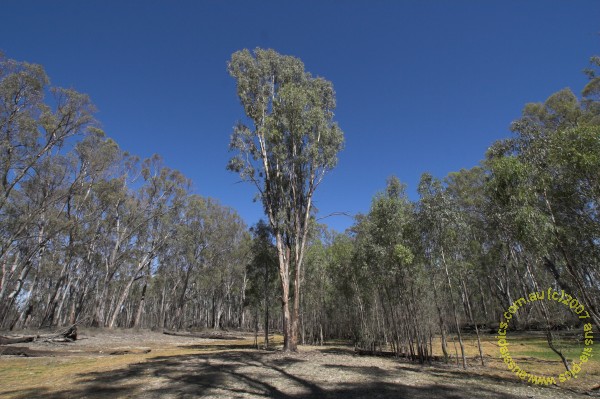
Not much going on here, just note the blueness of the sky. That's what it really looks like. There's no polarisor or anything for these.
..back to the menu at the top..

And I guess this is why the banks of the Murray are coated with fallen trees, all seeminly pointed
straight out to the middle of the river. I am thinking the trees grow on the bank until they
get too heavy for the wet soil, and then the next windy day, they topple in the easiest direction.
.. I could be wrong though.
.. I could be wrong though.
..back to the menu at the top..

..Yeah Yeah, don't get Cocky.
..back to the menu at the top..






















































































